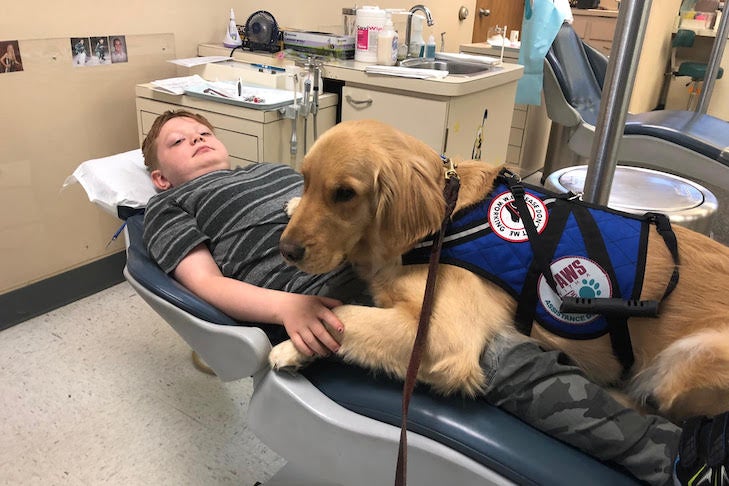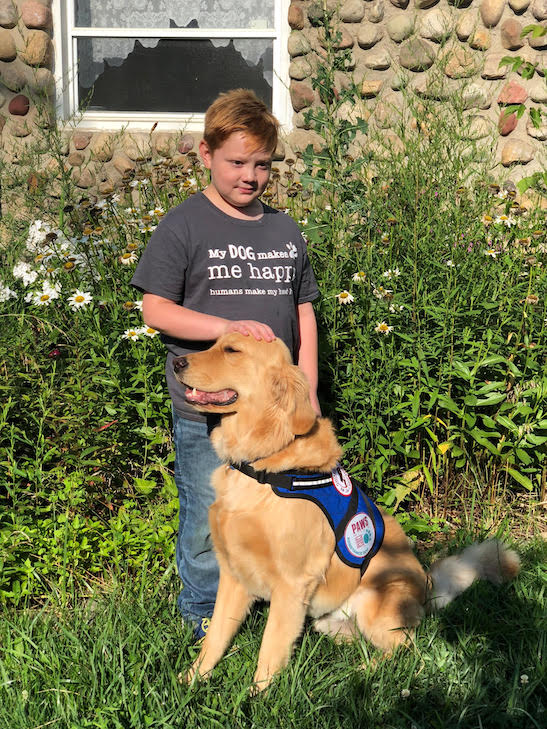
At ten years old, Cal’s life was a struggle. He had been diagnosed with autism a year earlier, and his family was working with a team of psychiatrists and counselors to find the right treatment for him.
But life was hard: he was “just not a happy kiddo,” says mom Brandy Keippala; “always upset and angry” because it was so hard for him to communicate his needs. Almost every weekday, there were long car rides to therapies: occupational, physical, speech and language, psychological.
He was heavily medicated—so much so, in fact, that the state government requested that his psychiatrist validate why he was taking so much medication. Medication had been a last resort, but with Cal frequently acting out, running away from home, or stripping and eating the foam from the padded walls of the isolation room at his school, and with his two siblings living with family and friends because home was no longer a safe environment—something had to give.
And even bigger changes were on the horizon. The situation had grown so untenable that Cal was about to enter the inpatient child psychiatric unit at the University of Michigan.
Then Arty came along.
Arty the Golden Retriever Reunites a Family
Arty is a Golden Retriever trained as an autism support dog by Paws with a Cause. Founded in 1979, Paws with a Cause has placed more than 3,100 dogs trained to assist people living with a variety of disabilities, including hearing dogs and seizure response dogs. The nonprofit’s newest program, founded more than a decade ago, places service dogs in homes with a child aged four to twelve who’s living with autism—with dramatic results. There are currently 68 Paws dogs living with a child with autism. Among them, Arty.
Mom Brandy says of the moment Cal and Arty met: “It was an instant thing for them.” At that point, she notes, Cal “would wear his hoodie and keep it up over his face 99 percent of the day. And when we left Paws, he put his hood down. It was the first time he was in public with his hood down.”

Cal takes his hood down in public for the first time, shortly after meeting Arty
In fact, the change in Cal was so instant and so dramatic that when the University of Michigan called three days after Arty’s arrival to say that a place was available in the inpatient psychiatric unit to which Cal had been scheduled to move, his parents were able to turn the room down. Within two weeks, the family was living under one roof again, and six months later, Cal was off 80 percent of his medications. “His psychiatrist was dumbfounded that we could start taking him off the higher doses of medication and the antipsychotics and such,” says Brandy.
How Dogs Help Children With Autism
Dogs in Paws with a Cause’s autism program provide much-needed companionship for children struggling with autism, helping them to form a strong emotional bond that leads to improved social and emotional bonds in the wider world, as well as improved verbal and nonverbal communication. The emotional soothing provided by the dog’s steady, loving presence also helps children with autism to regulate their emotions, drastically reducing stress in the family and often allowing children with autism the stability to pursue a greater range of interests.
Following a selection process, families admitted to the program are carefully matched with dogs based on their lifestyle, needs, temperament, and other factors. The dogs are then trained to meet the specific needs of the child they’re matched with. In Cal’s case, for instance, that means soothing Cal during medical appointments. “He had a lot of medical issues, related and unrelated to the autism,” Brandy explains, “and it would take five of us to hold him down to get a blood draw. After Arty, it was none of us.”
Instead of Cal’s family and medical professionals having to restrain Cal to draw blood—or having to use restraining ties—Arty climbs on top of Cal on the examination table—a “squish” method that works like a weighted blanket, calming Cal enough to have blood drawn.
Once a dog has been trained, trainers work in the home with the pup’s new family for six to eight months, making sure that the humans know how to care for and work with the newest member of the family.
So who are the dogs doing such important work? It takes a special pup: dogs with a lot of emotional intelligence, who can pick up on the needs of the child they’re placed with, and not be overwhelmed by possible yelling or enthusiastic or rough handling from children.
Best of all? The only charge to families in the program is the $25 application fee.

A New Future for Children With Autism and Their Families
These days, 13-year-old Cal is able to take Arty for walks alone, and his mom can even leave the two of them home with Cal’s older sister while she goes to the store—an unthinkable convenience, before Arty came along.
And having Arty around has so boosted Cal’s confidence that before the pandemic hit, Cal was able to stand up in front of hundreds of people to advocate for more children with autism having access to service dogs. Now that the pandemic has limited Cal’s movements in the world, Arty is always on the lookout for new ways to be helpful around the house—for instance, taking the initiative to collect people’s trash and take it to the trash can.
The situation at home has improved so much that mom Brandy has had the freedom to start a part-time job. “It’s not just one person that Arty changed life for,” she says. “It’s all of us, and everybody in Cal’s community.”
Applications for Paws with a Cause’s autism support dog program are open until April 30th. Paws with a Cause estimates that every assistance dog they place costs $35,000 to breed, raise, train, and place. To donate, please visit their website.

